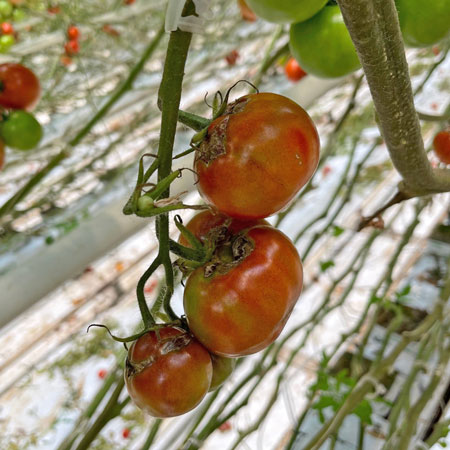5/1/2023
ToBRFV Prevention
Jennifer Polanz

Pictured: If you see this on your tomatoes, the jig is up. Infected plants need to be removed and destroyed.
Most greenhouse growers are either acutely aware of Tomato Brown Rugose Fruit Virus (ToBRFV) or have at least heard of it. In case it hasn’t struck you yet (or you want to prevent another outbreak), I saw these tips for prevention posted on LinkedIn by IPM Scoutek and reached out to co-founder Carrie Izsak to see if she minded if I shared. She said please do, so here they are:
Steps to protect against ToBRFV
If you grow vegetables in your greenhouse, you’ve likely heard about or have been faced with ToBRFV. This virus can cause severe damage to vegetable plants, leading to reduced yields and quality. It’s spread by a variety of pests, including thrips and whiteflies, and can be difficult to control once it’s been introduced to your greenhouse.
To protect your greenhouse crops from ToBRFV, the following strategies can be implemented:
1. Use virus-free seed or transplants: This is important to prevent introducing the virus into your greenhouse.
2. Implement strict sanitation protocols: This includes regular cleaning and disinfection of all equipment, tools and surfaces, as well as removing and destroying any infected plants.
3. Control insect vectors: ToBRFV is primarily spread by the Silverleaf whitefly, so controlling the population of these insects in your greenhouse is crucial. This can be achieved through the use of insecticides, sticky traps and cultural practices such as reflective mulch.
4. Implement strict movement controls: This includes limiting the movement of people and equipment in and out of your greenhouse, as well as using protective clothing and footwear when entering from an infected area.
5. Monitor your crop regularly: Regularly inspect your plants for symptoms of ToBRFV, such as brown rugose fruit, and take action immediately if any are found.
6. Using a combination of these strategies is likely to be more effective than using any one method alone.
7. Use of resistant varieties: Utilize varieties that have been bred to be resistant to ToBRFV.
8. Isolate new plants: Before introducing new plants to the greenhouse, isolate them for a period of time to ensure they don’t have the virus before putting them with the rest of the crop.